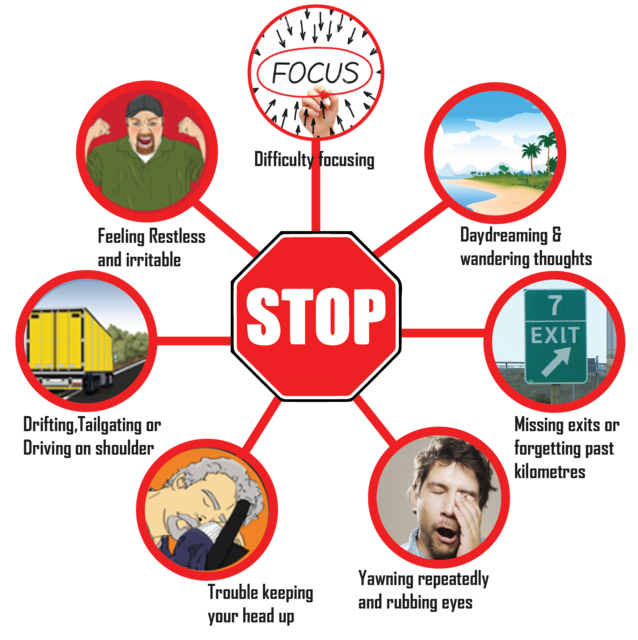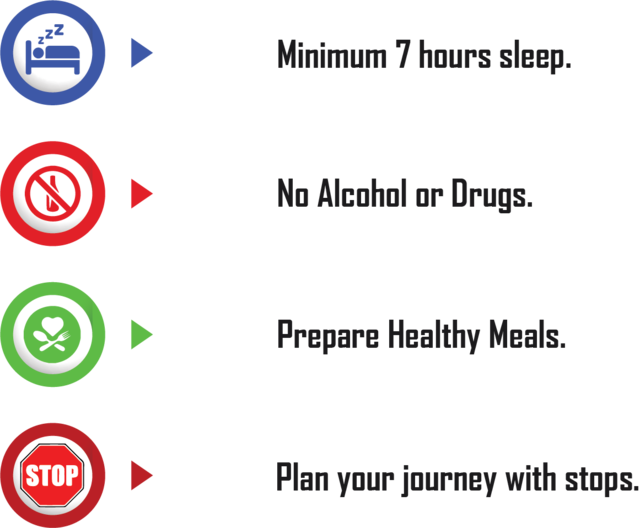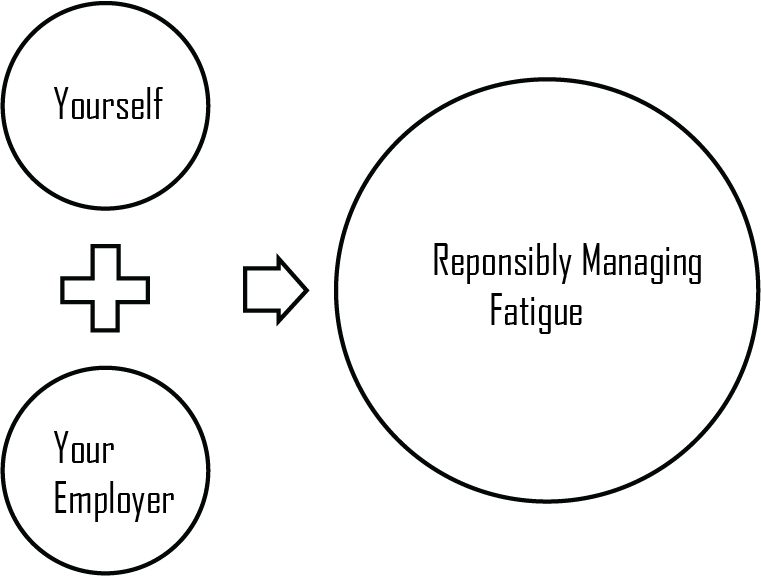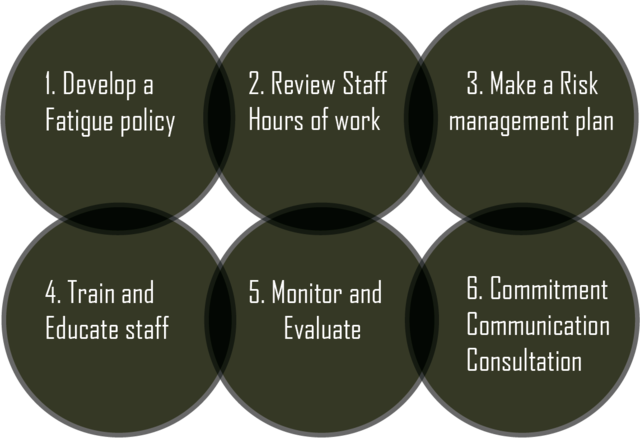

Commercial drivers are especially at risk of fatigue-related crashes because they work in shifts, drive at night against their natural body clock, start early in the morning and work in isolation.

- An accumulation of tiredness symptoms
- Gradual decline of physical & mental alertness
- Distorts judgement & reaction time
YOUR CIRCADIAN BIOLOGICAL CLOCK
Our Circadian biological clock regulates the timing of sleepiness and high alertness periods throughout the day. The Circadian rhythm dips and rises at different times of the day, so your strongest desire to sleep is generally around 2:00-4:00am and in the afternoon between 13:00 and 15:00pm. The sleepiness you feel during a CIRCADIAN DIP will be less intense if you have had a sufficient sleep and worse if you are sleep deprived.
Therefore if you are driving during these low alertness periods, you need to keep on top of other aspects of your health and wellbeing to combat it. If you don't look after yourself, these sleepiness periods will be worse than normal and may develop into fatigue.

Fatigue is not just tiredness, it has the same effects and risks as driving drunk.
It is crucial to identify the symptoms early and treat the causes before you become unfit to drive. If you are driving fatigued you not only put yourself at risk but also the lives of every road user that you encounter. The following chapters are identified as potential causes of fatigue.

If you are experiencing any of these symptoms while driving you need to pull over!
Driving and fatigue are a fatal mix. Think back to times you have drifted over the centre line, made sharp steering corrections, or not remembered a local landmark. These are common signs of fatigue.
If you think you have experienced any of these symptoms more than twice in a week, you may be suffering from fatigue and need to take a break.

OVER THE LAST 2 WEEKS HOW OFTEN HAVE YOU BEEN EXPERIENCING THESE SYMPTOMS?
Click the link below to see if you might be suffering from fatigue.

There are things you can do to successfully manage fatigue before it becomes a problem. It's not only work that can be a factor, other aspects of your life may be adding to the problem. These can include sleeping disorders, mental health, alcohol & drugs, diet and exercise. These will be talked about in the following chapters as factors that can cause fatigue. Preventing fatigue is more important than trying to managing it.
If you think you suffer fatigue while driving you will need to take a proper break as soon as possible. Temporary measures to stay alert & awake include

Immediately pull your vehicle over into a safe location.
![]()
Take a short nap. Even a 20-30 minute nap will help to restore alertness.
![]()
Have a rest break. Do stretches, walk around your truck, jump on the spot.
![]()
Have a coffee or sports drink. Be cautious of over consumption.
![]()
Mental alertness techniques, including signing.
![]()
Drink plenty of water. Always have a bottle on hand.


- Clean your windshield and mirrors regularly
- At night reduce the intensity of dashboard lights
- Do not place any items on the dashboard
- Have your eyes checked regularly
- Drink plenty of water


You are more likely to prevent driver fatigue if you develop a fatigue prevention plan. A fatigue prevention plan details how an operator proposes to prevent the fatigue risks inherent in any road transport operation.

FATIGUE IS A WORKPLACE HAZARD!
Each party must ensure that they do not make unrealistic demands. Preventing workplace fatigue requires COOPERATION and COMPROMISE between employers and employees.

Chain of responsibility recognises that all the people who influence driver behaviour and compliance must be held accountable. This includes directors of companies. Under Chain of Responsibility, the responsibility is shared - it is not transferred.
Consignor
Scheduler
Operator
Dispatcher
Packer
Driver
Loader
Receiver
EVERYONE is responsible

It is both the employers responsibility and the operator to access the risk of fatigue in their workplace. Employers need to review their current operations and identify the risk factors and fatigue hazards. Compliance with regulated work time hours does not mean that a driver is not exposed to a fatigue risk and it does not mean that you can avoid the requirement to prevent driver fatigue in your workplace.
FATIGUE RISKS THAT CANNOT BE ELIMINATED, ISOLATED OR MINIMISED MUST BE REMOVED FROM YOUR WORKPLACE
Drivers and operators are responsible for identifying fatigue hazards that they come across during the work that they undertake.
This includes any issues with rosters, trips and scheduling that may induce fatigue. These hazards need to be raised with managers and employers so that they can include them in their fatigue prevention plan.
These are the steps involved to integrate a fatigue prevention plan into your workplace:

It is the employers responsibility to review the current workplace processes, schedules and rosters. They need to consider the following fatigue risks, provided by NZTA.
- What length of shift is usually worked in a day?
- How often is night work which includes driving undertaken?
- What is the normal length of a rest break to get sleep: – on a day shift? – on a night shift?
- How many hours are normally worked in a week?
- How long is a normal continuous work period without a rest break?
- How many days off in a week are there?
- How frequently do staff including drivers get two consecutive nights off?
- Ask drivers if there are particular trips or schedules they find more tiring and whether times to complete work tasks are realistic.
- Monitor speeding fines and look into the reasons given for incurring these.
- Look at any instances of working hours or logbook breaches.
- Look at insurance claim data.
- Identify drivers who are required to travel long distances to get to or from the place they start work.
- Finally, are there any incident reports for your company in the last year that are or could be fatigue related?
After reviewing these fatigue risk factors:

Are there any situations that increase the chances of a fatigue hazard in your workplace?
If so, how regular does this fatigue hazard occur?

If the answer is 'regularly' you need to look at how you can eliminate, isolate or minimise the risk.
E.g. plan trips that allow plenty of time to sleep is one way of minimising fatigue risk.
If you are an employee concerned about fatigue risk in your workplace, make sure you talk to your employer or manager about it. Note down any fatigue related incidences, near misses or even times where you felt overly tired. They will need to include this in their fatigue prevention plan. For more information about how to develop a fatigue prevention plan as part of your health and safety policy, take a look at the Shiftwork Services Fatigue-Risk Management Policy Development Checklist.
CHAIN OF RESPONSIBILITY WEAKNESSES:
- Lack of flexibility for pick up or delivery hours
- Financial pressure that often takes priority over a driver's fatigue risk
- Unsatisfactory sleeping conditions in trucks
- Poor planning from dispatchers or schedulers
- Vehicles that are ill suited for the type of job
- Inadequate training and communication with staff about fatigue risks
- Non-existent or poor fatigue management practices at work
- Having a second job or social life that limits sleep
- Poor management of sleeping disorders
- Heavy evening meals or poor food choices






